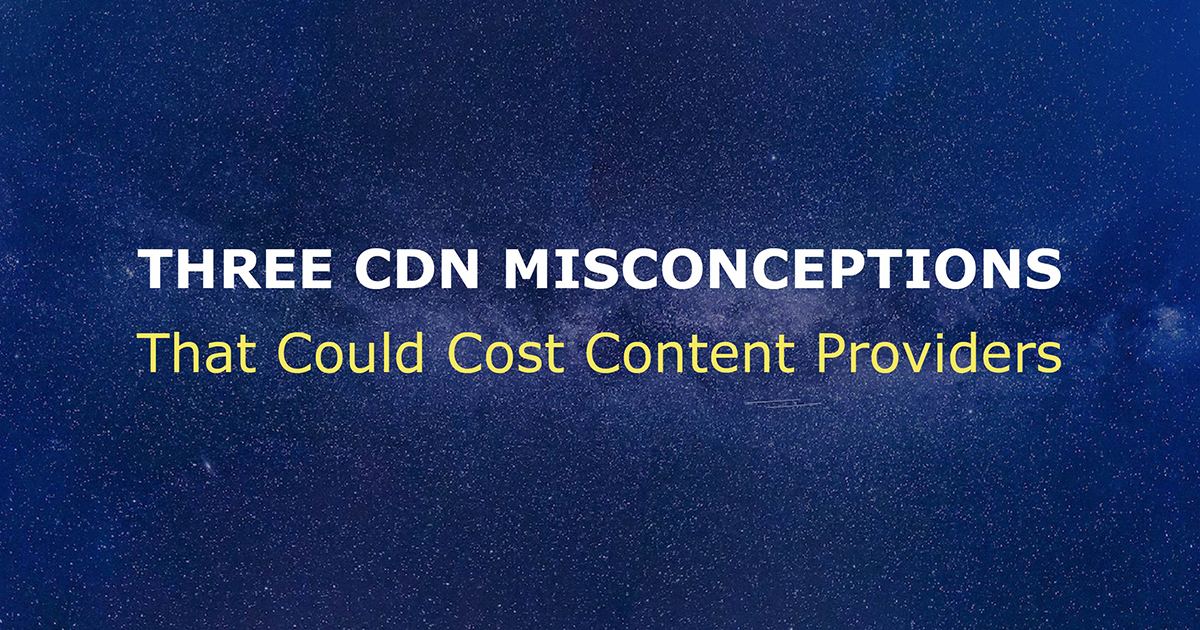Three CDN Misconceptions That Could Cost Content Providers

Outside of the few content owners that operate their own CDN, third-party CDN vendors deliver nearly every byte of Internet-related information, content, and data that exists. For all intents and purposes, their customers are almost literally everyone in the world.
CDNs provide two essential components for how we consume media today. First, they enable the wide distribution of content using a 1:1 distribution method. Thanks to the Internet and CDNs, content providers can deliver content whenever and wherever it’s requested and get much more information about their viewers (and their preferences) than broadcast TV ever allowed. This means content providers can essentially understand their audience down to a single viewer with the goal of offering individualized experiences so they stay engaged and subscribed.
Second, CDNs provide the scale needed to deliver all this streamed content, which amounts to tens of billions of hours yearly. To handle this level of distribution, CDNs work with Telcos and ISPs to serve streaming media to everyone requesting it, wherever they’re located, in the best possible response time and with the best possible quality. That’s a staggeringly huge lift, and it’s only getting harder as VOD and live streaming grows.
CDN Assumptions: What Content Providers Should Know
A few common assumptions about CDNs have caused the bigger picture to be often misunderstood, and I’m determined to shed more light on these areas. These assumptions might seem small or insignificant, but with increased streaming demand and major shifts like live streaming sports, they could negatively impact the media industry in the long term.
-
- Assumption 1: Large CDNs are connected to all ISPs, even remote ones
While large CDNs are connected to remote ISPs in “theory”, the idea that they are directly connected can be false. Think of the CDN<>ISP ecosystem like an onion. Global CDNs are only directly connected to the handful of larger networks surrounding them. In reality, most ISPs are indirectly connected to large CDNs, sometimes multiple network hops away (in the outer onion “layers”). These ISPs are often smaller and serve less populated subscriber networks – a fact that comes with its own set of problems around upstream capacity and potential impacts on QoE, especially when network traffic spikes.
- Assumption 1: Large CDNs are connected to all ISPs, even remote ones
-
- Assumption 2: Large CDNs ensure packets are always delivered quickly and reliably
While global routes allow content providers to send packets anywhere, they have no control over the efficiency of packet delivery from the CDN to the next connected network – or even the pathways data packets take as they travel across the Internet. Content providers may know that the packet arrived, but how well did it flow to the ISP network further downstream? Did it have to be sent three times because it got dropped due to network congestion?From the somewhat centralized position of a large CDN, it’s difficult to validate and verify every connection to every ISP, especially those located further downstream. Unfortunately, content providers often have little visibility into how quickly or reliably packets reach their destination. Blind spots in content delivery and performance metrics are becoming a big problem that could impact revenue or induce subscriber churn.
- Assumption 2: Large CDNs ensure packets are always delivered quickly and reliably
-
- Assumption 3: Recent funding (e.g., fiber to the home) means we can now deliver higher-quality service in hard-to-reach networks
Global initiatives like Project Gigabit in the UK have recently been greenlit to fund new ISPs and AltNets serving broadband and wireless Internet in remote networks. While this is a big step in the right direction, the reality is that managing content delivery just got more complicated. With further-reaching access to fiber, content providers may not realize the backhaul capacity issues that ISPs now face, especially with the surge in live streaming. When network congestion drives consumption upstream (like live sports events often do), everything is ultimately connected to the same large CDN, and every smaller ISP suffers.Some ISPs even have to rebuild portions of their network to handle the scale, which can be costly and disruptive. Scale problems are already complicated, and live streaming with large concurrent viewers is setting up an even bigger battle. Receiving more volume at a higher rate means less time to solve an issue. With subscribers quick to complain on social media and treating contract-free subscriptions as disposable, content providers should carefully consider whether they have the right delivery partners in place.
- Assumption 3: Recent funding (e.g., fiber to the home) means we can now deliver higher-quality service in hard-to-reach networks
As the demand for video content and live streaming continues to multiply and consumption becomes ever more individualized, these issues will only get more amplified and complex. In upcoming posts, I’ll expand on these challenges and how content providers can get ahead of them. Here’s a hint: thinking smaller and getting more granular will ultimately support the bigger picture.
